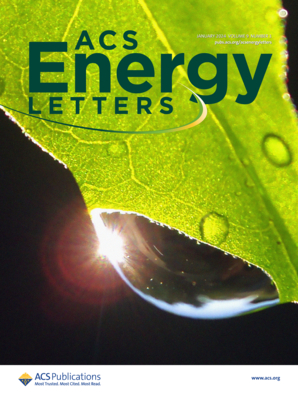Activation of Nonoxide Photocatalyst Sheet Operable under Visible Light Irradiation up to 600 nm by Conductive Bilayer
IF 18.2
1区 材料科学
Q1 CHEMISTRY, PHYSICAL
引用次数: 0
Abstract
Particulate photocatalyst sheets allow for scalable sunlight-driven overall water splitting. Photocatalyst sheets composed of doped-La5Ti2Cu0.9Ag0.1O7S5 (LTCA), gallium zinc oxynitride (GaN:ZnO), and Au as the hydrogen evolution photocatalyst, oxygen evolution photocatalyst, and conductor layer, respectively, are promising candidates because of their long absorption edge wavelengths (700 and 600 nm, respectively). However, the actual performance of this sheet has been poor due to the large Schottky barrier at the GaN:ZnO/Au interface. Here, we developed a photocatalyst sheet incorporating conductive thin Au and thick Ti bilayer films having high and low work functions, respectively, which increased the activity by a factor of 6 compared with that of a single Au layer sheet. An optimized doped-LTCA/Au/Ti/CoOx/GaN:ZnO sheet modified with CoOx and Cr2O3/Rh cocatalysts exhibited a solar-to-hydrogen energy conversion efficiency of 0.3%. This work provides a key strategy based on the utilization of narrow bandgap oxynitride materials to construct efficient visible-light-driven nonoxide-based sheets.

通过导电双分子层激活可在 600 纳米可见光照射下工作的非氧化物光催化剂薄片
微粒光催化剂片可实现可扩展的太阳光驱动的整体水分离。由掺杂-La5Ti2Cu0.9Ag0.1O7S5(LTCA)、氧化锌镓(GaN:ZnO)和金组成的光催化剂薄片分别作为氢进化光催化剂、氧进化光催化剂和导体层,由于其吸收边缘波长较长(分别为 700 纳米和 600 纳米),因此是很有前途的候选材料。然而,由于 GaN:ZnO/Au 界面存在较大的肖特基势垒,这种薄片的实际性能一直不佳。在此,我们开发了一种光催化剂薄片,其中包含导电的薄金双层膜和厚钛双层膜,它们分别具有较高和较低的功函数,与单金层薄片相比,其活性提高了 6 倍。用 CoOx 和 Cr2O3/Rh 催化剂修饰的优化掺杂-LTCA/Au/Ti/CoOx/GaN:ZnO 薄膜显示出 0.3% 的太阳能-氢能转换效率。这项工作为利用窄带隙氮氧化物材料构建高效的可见光驱动型非氧化物基薄片提供了一种关键策略。
本文章由计算机程序翻译,如有差异,请以英文原文为准。
求助全文
约1分钟内获得全文
求助全文
来源期刊

ACS Energy Letters
Energy-Renewable Energy, Sustainability and the Environment
CiteScore
31.20
自引率
5.00%
发文量
469
审稿时长
1 months
期刊介绍:
ACS Energy Letters is a monthly journal that publishes papers reporting new scientific advances in energy research. The journal focuses on topics that are of interest to scientists working in the fundamental and applied sciences. Rapid publication is a central criterion for acceptance, and the journal is known for its quick publication times, with an average of 4-6 weeks from submission to web publication in As Soon As Publishable format.
ACS Energy Letters is ranked as the number one journal in the Web of Science Electrochemistry category. It also ranks within the top 10 journals for Physical Chemistry, Energy & Fuels, and Nanoscience & Nanotechnology.
The journal offers several types of articles, including Letters, Energy Express, Perspectives, Reviews, Editorials, Viewpoints and Energy Focus. Additionally, authors have the option to submit videos that summarize or support the information presented in a Perspective or Review article, which can be highlighted on the journal's website. ACS Energy Letters is abstracted and indexed in Chemical Abstracts Service/SciFinder, EBSCO-summon, PubMed, Web of Science, Scopus and Portico.
 求助内容:
求助内容: 应助结果提醒方式:
应助结果提醒方式:


